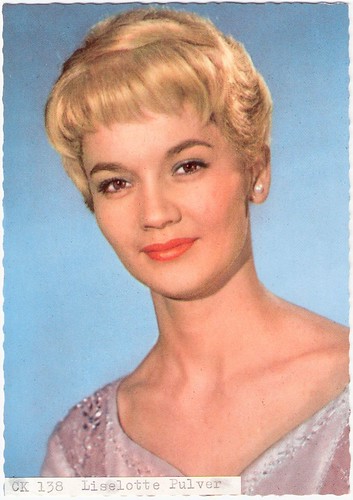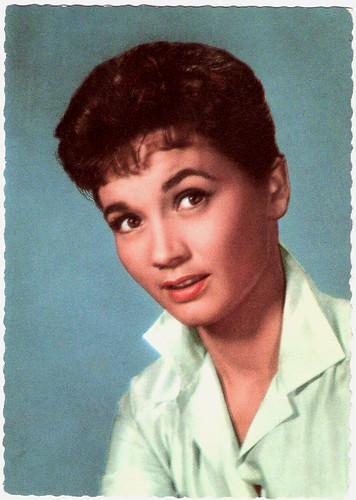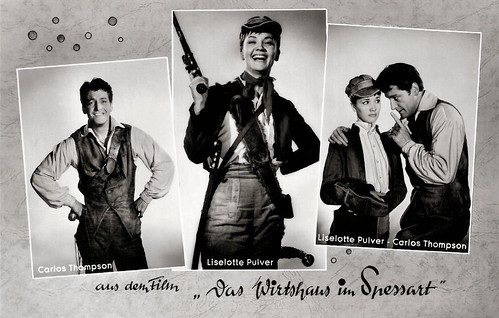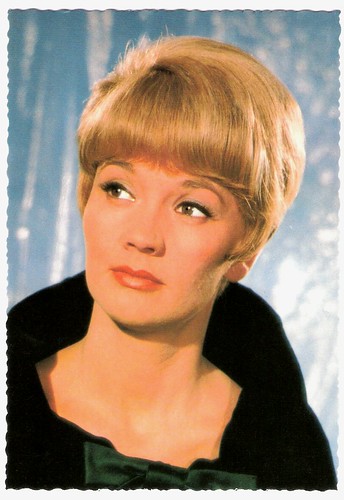Swiss actress Liselotte Pulver (1929) was one of the most beloved stars of the German popular cinema of the 1950s and early 1960s. Despite a wide variety of roles, she is best remembered as the merry tomboy in sparkling comedies like Das Wirtshaus im Spessart/The Spessart Inn (1958).
Image may be NSFW.
Clik here to view.
German postcard by ISV, no. E 16. Photo: Witt-Film / Constantin / Bokelberg.
Image may be NSFW.
Clik here to view.
German postcard by UFA, no. CK-237. Retail price: 30 Pfg. Photo: Joe Niczky / Ufa. Collection: Egbert Barten.
Image may be NSFW.
Clik here to view.
German postcard by Universum-Film Aktiengesellschaft (UFA), Berlin-Tempelhof, no. CK-138. Photo: Ringpress / Vogelmann.
Image may be NSFW.
Clik here to view.
German postcard by WS-Druck, Wanne-Eickel, no. F. 15. Photo: Ringpress.
Image may be NSFW.
Clik here to view.
German postcard by WS-Druck, Wanne-Eickel, no. F 42. Photo: Collignon.
Image may be NSFW.
Clik here to view.
German postcard by Ufa, Berlin-Tempelhof, no. CK 166. Retail price: 30 Pfg. Photo: Universal-Film Inc.
Image may be NSFW.
Clik here to view.
German collectors card by Lux.
Liselotte (nicknamed Lilo) Pulver was born in Bern, Switzerland, in 1929. She was the youngest daughter of civil engineer Fritz Eugen Pulver and his wife Germaine. Her older sister was journalist Corinne Pulver.
From 1945 on Liselotte attended commercial school. After graduating in 1948, she started to work as a mannequin and took acting classes at the Berner Konservatorium(Bern conservatory). She made her stage debut at the Stadttheater Bern (Bern Theatre), and from 1949 to 1951 she appeared at the renowned Schauspielhaus Zurich.
Austrian film director Leopold Lindtberg cast the 20-year-old actress in his Swiss-American comedy Swiss Tour/Four Days Leave (Leopold Lindtberg, 1950) starring Cornel Wilde. After this debut, she inaugurated a long career in European films.
She first starred alongside Hans Albersin the mountain drama Föhn/White Hell (Rolf Hansen, 1950). Then she worked for the first time with director Kurt Hoffmann on the crime comedy Klettermaxe (1952). They would make 10 films together.
Her first box office hits were the Swiss film Uli der Knecht/Uli the Servant (Franz Schnyder, 1954) and its sequel Uli der Pächter/Uli the Tenant (Franz Schnyder, 1955).
Her breakthrough role was a Puszta school girl in Ich denke oft an Piroschka/I Often Think of Piroschka (Kurt Hoffmann, 1955). This Heimatfilm was not situated in Germany but in the Hungarian provinces, known as the Puszta. By focusing on the cultural differences between a German student on holidays and his Hungarian hosts as well as the student's unfamiliarity with rural life, Hoffmann created a sparkling comedy. Stephanie D'heil at Steffi-line writes that it made Pulver the German equivalent of Audrey Hepburn.
Another big hit was the fairy tale Das Wirtshaus im Spessart/The Spessart Inn (Kurt Hoffmann, 1958), in which she played a lovely countess who dresses up as a man to join a gang of robbers. The huge success of this film made her the prototype tomboy of the German cinema of the 1950s, with her hearty and joyful laughter as her trademark. Das Wirtshaus im Spessart inspired two sequels in 1960 and 1967, both directed by Hoffmann and starring Pulver.
Image may be NSFW.
Clik here to view.
German postcard by Kolibri-Verlag, no. 648. Photo: Europa Filmverleih. Publicity still for Klettermaxe/Corry Bell (Kurt Hoffmann, 1952) with Albert Lieven.
Image may be NSFW.
Clik here to view.
Belgian card. Photo: Meteor / Schorchtfilm.
Image may be NSFW.
Clik here to view.
French postcard by Edition du Globe, Paris, no. 712. Photo: Sam Lévin.
Image may be NSFW.
Clik here to view.![Liselotte Pulver]()
Dutch postcard by Gebr. Spanjersberg NV, Rotterdam, no. 4527. Photo: Ringpress / Vogelmann / Ufa.
Image may be NSFW.
Clik here to view.![Liselotte Pulver, Helmut Schmid]()
With husband Helmut Schmid. German postcard by Eduard Huber Verlag, Grünwald.
Image may be NSFW.
Clik here to view.![Liselotte Pulver]()
Swiss postcard by Linda Color, Genève. Photo: Erwin Schneider.
Quickly Liselotte Pulver rose to international fame. She starred in the French crime film Les aventures d’Arsène Lupin/The Adventures of Arsène Lupin (Jacques Becker, 1957), as well as in the American Erich Maria Remarque adaptation A Time to Love and a Time to Die (Douglas Sirk, 1958).
Alongside French idol Gérard Philipe she starred in Le joueur/The Gambler (Claude Autant-Lara, 1958), an adaptation of Fyodor Dostoyevky's novel. She was considered to play leading roles in the Hollywood epics Ben-Hur (1959) and El Cid (1961), but she had already signed for other projects in Germany. She later said that this had been the biggest disappointment in her career.
In Germany, she starred in Die Zürcher Verlobung/The Affairs of Julie (Helmut Käutner, 1957), Das Glas Wasser/A Glass of Water (Helmut Käutner, 1960), and the Thomas Mann adaptations Bekenntnisse des Hochstaplers Felix Krull/Confessions of Felix Krull (Kurt Hoffmann, 1957) and Buddenbrooks (Alfred Weidenmann, 1959).
She proved her talent for slapstick in the comedy One, Two, Three (Billy Wilder, 1961). As busty, blonde Fraulein Ingeborg, the gum chewing secretary of philandering Coca-Cola executive James Cagney she was hilarious. For her role as a Russian woman in the Bob Hope comedy A Global Affair (Jack Arnold, 1963) she was nominated for the Golden Globe Awardas best supporting actress. Artistically, her performance as a lesbian abbess in La Religieuse/The Nun (Jacques Rivette, 1966) became the highlight of her career.
In 1960, she had met Swiss actor Helmut Schmid on the set of Gustav Adolfs Page (Rolf Hansen, 1960), and they married the following year. The couple had two children, son Marc-Tell (1962) and daughter Melisande (1967).
More and more she focussed on television and she appeared in several TV-series. From 1977 to 1983, she co-hosted Sesamstrasse, the German version of Sesame Street. In 1980, she won the Filmband in Goldfor her longtime achievements in the German cinema. Furthermore, she published her memories … wenn man trotzdem lacht (If one laughs nevertheless) (1990). There were some tragedies in her private life. Her daughter Melisande committed suicide in 1989, and her husband, Helmut Schmid, died in 1992 of a heart attack.
Her last film was the hit comedy Das Superweib/The Superwife (Sönke Wortmann, 1996) with Heiner Lauterbach. On TV she was last seen in a remake of her film Die Zürcher Verlobung/The Affairs of Julie (Stephan Meyer, 2007) with Christoph Waltz.
Nowadays Liselotte Pulver lives secluded in her mansion in Perroy, on the shores of Lake Geneva. She also has an apartment at the Burgerheim, a retirement home near Bern.
Image may be NSFW.
Clik here to view.![Liselotte Pulver, Carlos Thompson]()
German postcard by Franz Josef Rüdel, Filmpostkartenverlag, Hamburg-Bergedorf, no. 2374. Photo: Witt / Constantin / Ringpress / Vogelmann. Publicity card for Das Wirtshaus im Spessart/The Spessart Inn (1958) with Carlos Thompson.
Image may be NSFW.
Clik here to view.![Gérard Philipe, Liselotte Pulver]()
East-German postcard by VEB Progress Film-Vertrieb, no. 2699. Retail price: 0,20 MDN. Photo: publicity still for Le joueur/The Gambler (Claude Autant-Lara, 1958) with Gérard Philipe.
Image may be NSFW.
Clik here to view.![Liselotte Pulver]()
German postcard by Kolibri-Verlag G.m.b.H., Minden-Westf., no. 1389. Photo: Witt / Constantin / Grimm. Publicity still for Das Spukschloss im Spessart/The Haunted Caste (Kurt Hoffmann, 1960).
Image may be NSFW.
Clik here to view.![Liselotte Pulver, Georg Thomalla, Curt Bois]()
East-German postcard by VEB Progress Filmvertrieb, no. 1547, 1961. Photo: publicity still for Das Spukschloss im Spessart/The Haunted Castle (Kurt Hoffmann, 1960) with Georg Thomalla and Curt Bois.
Image may be NSFW.
Clik here to view.![Liselotte Pulver]()
East-German postcard by VEB Progress Film-Vertrieb, Berlin, no. 2151, 1964. Retail price: 0,20 DM. Photo: Progress.
Image may be NSFW.
Clik here to view.![Heinz Rühmann, Liselotte Pulver]()
East-German postcard by VEB Progress Film-Vertrieb, Berlin, no. 2662, 1966. Retail price: 0,20 DM. Photo: Progress. Publicity still for Hokuspokus oder: Wie lasse ich meinen Mann verschwinden...?/Hocuspocus (Kurt Hoffmann, 1966) with Heinz Rühmann.
Image may be NSFW.
Clik here to view.![Liselotte Pulver]()
German postcard by ISV, no. E 37. Photo: Constantin. Publicity still for Hokuspokus oder: Wie lasse ich meinen Mann verschwinden...?/Hocuspocus (Kurt Hoffmann, 1966).
Image may be NSFW.
Clik here to view.![Liselotte Pulver and Harald Leipnitz in Herrliche Zeiten im Spessart (1967)]()
Romanian postcard by Casa Filmului Acin, no. 368. Photo: publicity still for Herrliche Zeiten im Spessart/Glorious Times in the Spessart (Kurt Hoffmann, 1967) with Harald Leipnitz.
Scene from Das Wirtshaus im Spessart/The Spessart Inn (1958). Source: Klarinettenqueen (YouTube).
Sources: Stephanie D'heil (Steffi-line) (German), Hal Erickson (AllMovie), Filmportal.de, Wikipedia and IMDb.
Image may be NSFW.
Clik here to view.

German postcard by ISV, no. E 16. Photo: Witt-Film / Constantin / Bokelberg.
Image may be NSFW.
Clik here to view.

German postcard by UFA, no. CK-237. Retail price: 30 Pfg. Photo: Joe Niczky / Ufa. Collection: Egbert Barten.
Image may be NSFW.
Clik here to view.

German postcard by Universum-Film Aktiengesellschaft (UFA), Berlin-Tempelhof, no. CK-138. Photo: Ringpress / Vogelmann.
Image may be NSFW.
Clik here to view.

German postcard by WS-Druck, Wanne-Eickel, no. F. 15. Photo: Ringpress.
Image may be NSFW.
Clik here to view.

German postcard by WS-Druck, Wanne-Eickel, no. F 42. Photo: Collignon.
Image may be NSFW.
Clik here to view.

German postcard by Ufa, Berlin-Tempelhof, no. CK 166. Retail price: 30 Pfg. Photo: Universal-Film Inc.
Image may be NSFW.
Clik here to view.

German collectors card by Lux.
First Box Office Hits
Liselotte (nicknamed Lilo) Pulver was born in Bern, Switzerland, in 1929. She was the youngest daughter of civil engineer Fritz Eugen Pulver and his wife Germaine. Her older sister was journalist Corinne Pulver.
From 1945 on Liselotte attended commercial school. After graduating in 1948, she started to work as a mannequin and took acting classes at the Berner Konservatorium(Bern conservatory). She made her stage debut at the Stadttheater Bern (Bern Theatre), and from 1949 to 1951 she appeared at the renowned Schauspielhaus Zurich.
Austrian film director Leopold Lindtberg cast the 20-year-old actress in his Swiss-American comedy Swiss Tour/Four Days Leave (Leopold Lindtberg, 1950) starring Cornel Wilde. After this debut, she inaugurated a long career in European films.
She first starred alongside Hans Albersin the mountain drama Föhn/White Hell (Rolf Hansen, 1950). Then she worked for the first time with director Kurt Hoffmann on the crime comedy Klettermaxe (1952). They would make 10 films together.
Her first box office hits were the Swiss film Uli der Knecht/Uli the Servant (Franz Schnyder, 1954) and its sequel Uli der Pächter/Uli the Tenant (Franz Schnyder, 1955).
Her breakthrough role was a Puszta school girl in Ich denke oft an Piroschka/I Often Think of Piroschka (Kurt Hoffmann, 1955). This Heimatfilm was not situated in Germany but in the Hungarian provinces, known as the Puszta. By focusing on the cultural differences between a German student on holidays and his Hungarian hosts as well as the student's unfamiliarity with rural life, Hoffmann created a sparkling comedy. Stephanie D'heil at Steffi-line writes that it made Pulver the German equivalent of Audrey Hepburn.
Another big hit was the fairy tale Das Wirtshaus im Spessart/The Spessart Inn (Kurt Hoffmann, 1958), in which she played a lovely countess who dresses up as a man to join a gang of robbers. The huge success of this film made her the prototype tomboy of the German cinema of the 1950s, with her hearty and joyful laughter as her trademark. Das Wirtshaus im Spessart inspired two sequels in 1960 and 1967, both directed by Hoffmann and starring Pulver.
Image may be NSFW.
Clik here to view.

German postcard by Kolibri-Verlag, no. 648. Photo: Europa Filmverleih. Publicity still for Klettermaxe/Corry Bell (Kurt Hoffmann, 1952) with Albert Lieven.
Image may be NSFW.
Clik here to view.

Belgian card. Photo: Meteor / Schorchtfilm.
Image may be NSFW.
Clik here to view.

French postcard by Edition du Globe, Paris, no. 712. Photo: Sam Lévin.
Image may be NSFW.
Clik here to view.

Dutch postcard by Gebr. Spanjersberg NV, Rotterdam, no. 4527. Photo: Ringpress / Vogelmann / Ufa.
Image may be NSFW.
Clik here to view.

With husband Helmut Schmid. German postcard by Eduard Huber Verlag, Grünwald.
Image may be NSFW.
Clik here to view.

Swiss postcard by Linda Color, Genève. Photo: Erwin Schneider.
International Fame
Quickly Liselotte Pulver rose to international fame. She starred in the French crime film Les aventures d’Arsène Lupin/The Adventures of Arsène Lupin (Jacques Becker, 1957), as well as in the American Erich Maria Remarque adaptation A Time to Love and a Time to Die (Douglas Sirk, 1958).
Alongside French idol Gérard Philipe she starred in Le joueur/The Gambler (Claude Autant-Lara, 1958), an adaptation of Fyodor Dostoyevky's novel. She was considered to play leading roles in the Hollywood epics Ben-Hur (1959) and El Cid (1961), but she had already signed for other projects in Germany. She later said that this had been the biggest disappointment in her career.
In Germany, she starred in Die Zürcher Verlobung/The Affairs of Julie (Helmut Käutner, 1957), Das Glas Wasser/A Glass of Water (Helmut Käutner, 1960), and the Thomas Mann adaptations Bekenntnisse des Hochstaplers Felix Krull/Confessions of Felix Krull (Kurt Hoffmann, 1957) and Buddenbrooks (Alfred Weidenmann, 1959).
She proved her talent for slapstick in the comedy One, Two, Three (Billy Wilder, 1961). As busty, blonde Fraulein Ingeborg, the gum chewing secretary of philandering Coca-Cola executive James Cagney she was hilarious. For her role as a Russian woman in the Bob Hope comedy A Global Affair (Jack Arnold, 1963) she was nominated for the Golden Globe Awardas best supporting actress. Artistically, her performance as a lesbian abbess in La Religieuse/The Nun (Jacques Rivette, 1966) became the highlight of her career.
In 1960, she had met Swiss actor Helmut Schmid on the set of Gustav Adolfs Page (Rolf Hansen, 1960), and they married the following year. The couple had two children, son Marc-Tell (1962) and daughter Melisande (1967).
More and more she focussed on television and she appeared in several TV-series. From 1977 to 1983, she co-hosted Sesamstrasse, the German version of Sesame Street. In 1980, she won the Filmband in Goldfor her longtime achievements in the German cinema. Furthermore, she published her memories … wenn man trotzdem lacht (If one laughs nevertheless) (1990). There were some tragedies in her private life. Her daughter Melisande committed suicide in 1989, and her husband, Helmut Schmid, died in 1992 of a heart attack.
Her last film was the hit comedy Das Superweib/The Superwife (Sönke Wortmann, 1996) with Heiner Lauterbach. On TV she was last seen in a remake of her film Die Zürcher Verlobung/The Affairs of Julie (Stephan Meyer, 2007) with Christoph Waltz.
Nowadays Liselotte Pulver lives secluded in her mansion in Perroy, on the shores of Lake Geneva. She also has an apartment at the Burgerheim, a retirement home near Bern.
Image may be NSFW.
Clik here to view.

German postcard by Franz Josef Rüdel, Filmpostkartenverlag, Hamburg-Bergedorf, no. 2374. Photo: Witt / Constantin / Ringpress / Vogelmann. Publicity card for Das Wirtshaus im Spessart/The Spessart Inn (1958) with Carlos Thompson.
Image may be NSFW.
Clik here to view.

East-German postcard by VEB Progress Film-Vertrieb, no. 2699. Retail price: 0,20 MDN. Photo: publicity still for Le joueur/The Gambler (Claude Autant-Lara, 1958) with Gérard Philipe.
Image may be NSFW.
Clik here to view.

German postcard by Kolibri-Verlag G.m.b.H., Minden-Westf., no. 1389. Photo: Witt / Constantin / Grimm. Publicity still for Das Spukschloss im Spessart/The Haunted Caste (Kurt Hoffmann, 1960).
Image may be NSFW.
Clik here to view.

East-German postcard by VEB Progress Filmvertrieb, no. 1547, 1961. Photo: publicity still for Das Spukschloss im Spessart/The Haunted Castle (Kurt Hoffmann, 1960) with Georg Thomalla and Curt Bois.
Image may be NSFW.
Clik here to view.

East-German postcard by VEB Progress Film-Vertrieb, Berlin, no. 2151, 1964. Retail price: 0,20 DM. Photo: Progress.
Image may be NSFW.
Clik here to view.

East-German postcard by VEB Progress Film-Vertrieb, Berlin, no. 2662, 1966. Retail price: 0,20 DM. Photo: Progress. Publicity still for Hokuspokus oder: Wie lasse ich meinen Mann verschwinden...?/Hocuspocus (Kurt Hoffmann, 1966) with Heinz Rühmann.
Image may be NSFW.
Clik here to view.

German postcard by ISV, no. E 37. Photo: Constantin. Publicity still for Hokuspokus oder: Wie lasse ich meinen Mann verschwinden...?/Hocuspocus (Kurt Hoffmann, 1966).
Image may be NSFW.
Clik here to view.

Romanian postcard by Casa Filmului Acin, no. 368. Photo: publicity still for Herrliche Zeiten im Spessart/Glorious Times in the Spessart (Kurt Hoffmann, 1967) with Harald Leipnitz.
Scene from Das Wirtshaus im Spessart/The Spessart Inn (1958). Source: Klarinettenqueen (YouTube).
Sources: Stephanie D'heil (Steffi-line) (German), Hal Erickson (AllMovie), Filmportal.de, Wikipedia and IMDb.